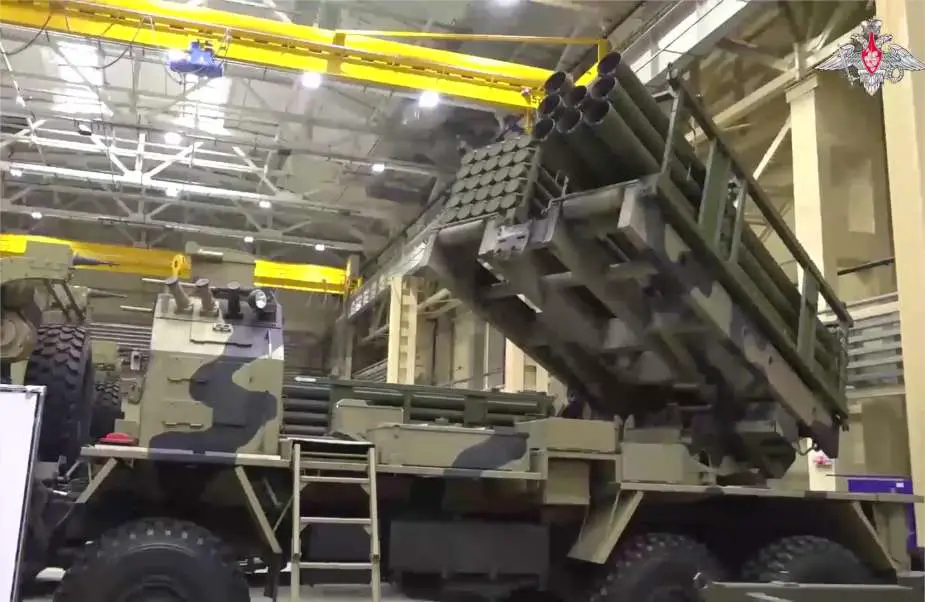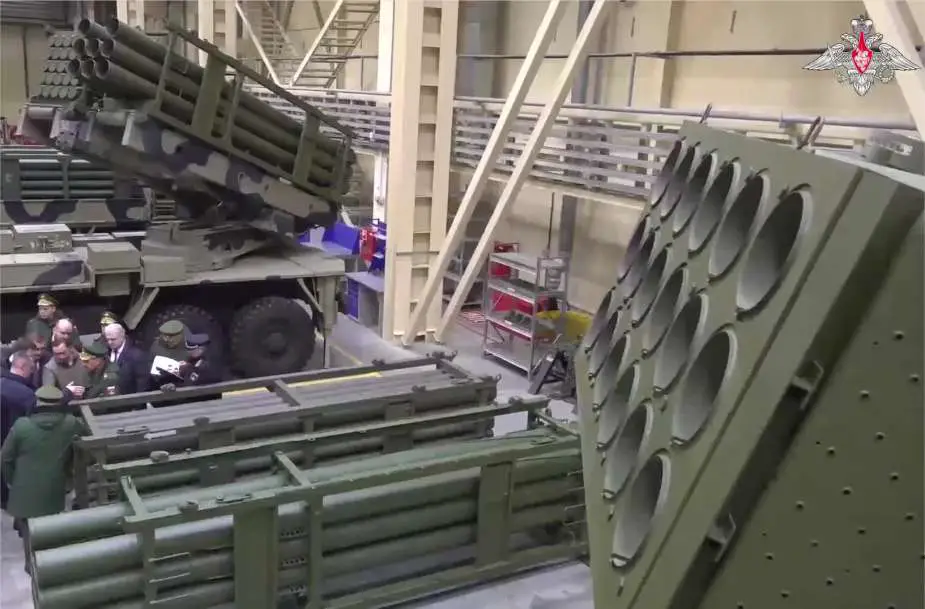Breaking news
Russia unveils new Vozrozhdenie system that combine rocket launch and mine deployment.
On February 28, 2024, during a visit to NPO Strela, Russian Defense Minister Sergei Shoigu was present for the unveiling of the new Vozrozhdenie bicaliber multiple launch rocket system (MLRS). The system, which translates to "Renaissance," is based on the ISDM Zemledeliye 8x8 mine-laying system. It can launch two types of munitions: 140mm mines intended for anti-tank or anti-personnel purposes, and 220mm rockets from various Russian MLRS systems, namely the BM-27 Uragan, TOS-1 Buratino, TOS-1A Solntsepek, and TOS-2 Tosochka.
Follow Army Recognition on Google News at this link

The Vozrozhdenie system is engineered to serve dual purposes: as a 220mm Multiple Launch Rocket System (MLRS) and as a remote-controlled mine-laying vehicle. (Picture source: Russian MoD)
The enterprise's lead reported that the introduction of 12-hour work shifts and new equipment acquisition has resulted in a doubling of the production rates within the current year. Plans are in place to further increase production output by fourfold by the year 2025. Additionally, the production goals for the Yastreb-AV and Zoopark-1M mobile radar systems, along with the Aistenok radar stations, were fully met in 2023.
The emergence of the Vozrozhdenie MLRS was first noted in Russian social media and later reported by Army Recognition on December 27, 2023. The system's development is part of a broader initiative by the Russian state corporation Rostec, aimed at enhancing the flexibility and firepower of the Russian artillery. Sergei Chemezov, General Director of Rostec, confirmed that production is expected to start in the first half of 2024.
The Vozrozhdenie is notable for its dual-capability design, allowing it to function both as a conventional MLRS using 220mm rockets and as a mine-laying platform with 140mm rockets. This adaptability makes it a significant addition to Russia's artillery forces, as the system supports different types of warheads, including high-explosive fragmentation, chemical, thermobaric, incendiary, and scatterable-mine submunitions.
The development of this new system has led to the introduction of a container that is compatible with 220mm rockets from various Russian Multiple Launch Rocket Systems (MLRS). The reloading process involves replacing these containers, which are available in both 140mm and 220mm sizes, using a designated transport-reloader vehicle (TZM). As a result, by quickly swapping containers, the Vozrozhdenie system is capable of engaging targets in both the immediate combat zone and further behind enemy lines. According to available footage, the Vozrozhdenie can be equipped with either one or two containers of 122mm ammunition, each containing 25 rounds, or one or two containers of 220mm ammunition, each containing 8 rounds.
In the absence of additional information from Sergei Chemezov, we have compiled existing data on the munitions used by the systems mentioned.
The BM-27 Uragan utilizes 220mm rockets that are equipped with high-explosive fragmentation, chemical, and scatterable-mine submunition warheads, with a range of 35 to 40 kilometers. It is capable of firing at a maximum rate of roughly one round per second and can be reloaded with a new set of 16 rockets within approximately 20 minutes. The BM-27 is designed to fire a variety of unguided artillery rockets, including types such as 9M27F (High Explosive), 9M27K1 (anti-personnel anti-material bomblets), 9M27K2 (anti-tank mines), 9M27K3 (anti-personnel minelets), and 9M59 (anti-tank mines with a directional charge).
The TOS-1 Buratino can fire up to 30 220mm rockets with thermobaric or incendiary warheads. These unguided rockets have a range from 600 meters to 4,000 meters and can be launched simultaneously within six seconds, creating a destruction zone of 200 by 400 meters.

The development of this new system has also led to the creation of a container that is compatible with 220mm rockets from various Russian Multiple Launch Rocket Systems (MLRS). (Picture source: Russian MoD)
The upgraded TOS-1A Solntsepek features 24 tubes for 220mm rockets and has an extended range of up to 6 kilometers, along with an improved ballistic computer. It retains the rapid-fire capability of the TOS-1 Buratino, allowing for a full salvo to be launched within six seconds. The munitions used, unguided missiles with incendiary or thermobaric warheads, create an aerosol cloud that ignites fuel-air explosions, making them particularly effective in mountainous or fortified areas.
In March 2020, Russia introduced a new rocket for the TOS-1A capable of reaching 10 kilometers, achieved by reducing the size and weight of the fuel-air explosive mixture in the warhead. This modification increased the minimum range from 400 meters to 1.6 kilometers, necessitating the continued use of the shorter-range M0.1.01.04M rocket for close-range scenarios.
The TOS-2 Tosochka, the latest advancement in Russian flamethrower and thermobaric rocket launcher systems, differs from its predecessors by using a wheeled platform and featuring automated aiming, shooting, and fire control systems. It does not require a transport-loading vehicle thanks to an integrated crane. Mounted on a 6x6 chassis, the extensively modernized TOS-1A launcher of the TOS-2 is capable of firing 220mm fuel-air explosive rockets or thermobaric ammunition from 18 launch tubes, effectively covering an area of six hectares. With thermobaric rockets, its range extends from 3.5 to 10 kilometers, with some sources suggesting it could reach up to 15 kilometers.
The Vozrozhdenie system, built on the ISDM Zemledeliye 8x8 mine-laying platform, will also serve as a remote mining vehicle when using 140mm caliber rockets. Similar to the ISDM Zemledeliye, it will have an estimated firing range of 5 to 15 kilometers and will be accompanied by a TZM (transport reloader vehicle).
For mobility, the Vozrozhdenie system is likely to utilize the same KamAZ-6560 8x8 chassis as the ISDM Zemledeliye. The KamAZ-6560, a robust military truck introduced in 2005, has a significant payload capacity of up to 20,000 kg and is powered by the KamAZ-740.35-400 turbocharged diesel engine, delivering 400 hp. It features a German-made ZF 6HP 602 automatic gearbox, can achieve a maximum road speed of 90 km/h, and has a maximum cruising range of 1,000 kilometers.



















